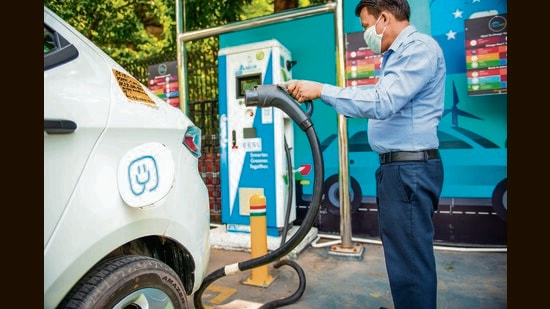Driving EV climate gains need rethink on charging
A major policy objective of transitioning to electric mobility is to decarbonise road transport that contributes to about 12% of India’s energy-related carbon dioxide emissions. And as in all complex problems, the devil is in the details
India has made major strides in battery-powered electric vehicles (EVs) over the past five years or so. From a 0.6% share in vehicle sales in 2018-19, EV sales (excluding buses) now account for 7.2%. We are now steadily closer to the double-digit mark. As per projections by other organisations, such as the International Energy Agency, the future looks bright too. Should we, therefore, be confident about achieving significant greenhouse gas (GHG) emission reduction from transport? A major policy objective of transitioning to electric mobility is to decarbonise road transport that contributes to about 12% of India’s energy-related carbon dioxide emissions. And as in all complex problems, the devil is in the details.

The benefit to climate by EVs in India is conditional. Prima facie, the absence of tailpipe emissions in EVs means reduction in direct vehicular carbon dioxide emissions. However, switching to EVs leads to shifting the energy source to a fleet of power plants. The greenness of power supply varies by country. In India’s case, fossil fuels meet as much as three-fourth of the country’s electricity requirement. Therefore, whether EVs can decarbonise India’s motorised road transport should be properly qualified.
Relying on simplified methodologies can misrepresent the true climate impact of electric mobility. The share of renewable energy, particularly solar and wind, in India’s power supply mix varies significantly throughout the day, influencing emissions associated with EV charging at different times. Current approaches also ignore the variability in EV charging pattern. Factors like vehicle use-case, travel characteristics, and availability of charging infrastructure influence when and where EVs are charged. Owing to the varying charging pattern, EVs may avoid GHG emissions significantly and deliver limited climate dividends or consume even more carbon space depending on their charging alignment with periods of high renewable energy availability. Current comparisons between select EV and conventional vehicle models fail to capture the diversity of vehicle energy performance within and across vehicle segments. This can lead to misleading generalisations about the overall impact of EV adoption.
The inherent energy efficiency advantage of electric drivetrain over internal combustion engine across two-wheeled and three-wheeled vehicles, passenger cars, and buses is well established. However, the emissions advantage of EVs diminishes when factoring in the annual average carbon burden of India’s grid electricity. That the majority charges EVs during evening or overnight, thereby increasing reliance on coal-based power and limiting any emission gains, is an eye-opener.
In the present scenario, charging during the day can potentially avoid nearly 10% extra emissions than during the evening, which is significant at a sector level. As the grid electricity mix becomes more solar dominate, the time-of-day emissions profile of EVs will get skewed further. Therefore, ensuring climate gains from EVs needs serious thinking.
This calls for coordinated action from policymakers, industry stakeholders, and consumers. First, by aligning EV charging with greener hours through time-of-day electricity tariffs (pricing electricity at lower rates during periods of high renewable energy supply to incentivise EV charging) tailored for regional contexts. Furthermore, providing access to public charging in sync with travel patterns and mainstreaming battery swapping as a charging solution (that gives the flexibility to charge EV batteries during daytime without requiring the EVs to be parked for that period). Second, nudging production and marketing of more efficient EV models by making energy labelling mandatory for traction battery packs and systems. Moreover, setting more stringent emission targets under future Corporate Average Fuel Economy (CAFE) enforcement cycles with expanded scope (currently applicable to passenger cars only). Last, coupling EV charging infrastructure with distributed renewable energy resources like solar photovoltaic panels through innovative renewable-energy-as-a-service mechanisms that enable procurement of renewable energy from off-site locations. One does not have to face practical difficulties (like limited space for installation and impact of shading) in generating solar energy on-site. End-of-life batteries can be an affordable and sustainable energy storage solution at charging stations for storing energy from renewable energy resources and delivering this clean electricity to charge EVs during evening and night-time.
By adopting this three-pronged strategy, India can harness the potential of EV transition to curb transportation emissions and drive its mobility to a sustainable future. Not to forget, the government has offered quite significant explicit and implicit fiscal incentives through subsidies and preferential tax-treatments to promote EV adoption. It is in the national interest to make these supports count.
Shyamasis Das is fellow at the Centre for Social and Economic Progress, New Delhi.The views expressed are personal





